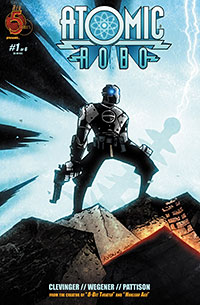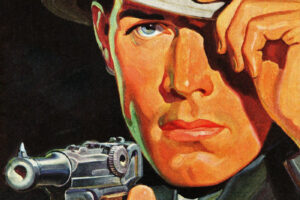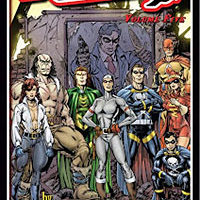
A comic-book character I recently looked into is Atomic Robo. I had first noticed him when I saw some pulp-inspired covers. So I decided to check him out. I’ve really enjoyed the series, though I only get the collections.
Atomic Robo is an intelligent and self-aware robot built by Nikola Tesla in the 1920s. Many people may have heard of Tesla, but may not be aware that the inventor did pioneering work in radio and electricity, working out alternating current (AC). Thomas Edison pushed for direct current (DC), which had issues. For many years Tesla worked to create a means of broadcasting electricity, but sadly died without succeeding. Obviously, for this series, the creators took some liberties with Tesla and his life.
The “Atomic Robo” series was created by writer Brian Clevinger and artist Scott Wegener as a series of mini-series that are later collected into trade paperback (now up to volume eight). A companion series with art by others is titled Atomic Robo Presents Real Science Adventures, the later issues of which have focused on the adventures of Tesla and others known as the Centurions of Science in the late 1800s.
The star of the series is, of course, Atomic Robo. He is a very human character, having a sense of humor (he is apparently based on Clevinger’s grandfather), but also a strong sense of ethics. When we see him during his early years, he has almost a kid-like quality to him, enjoying pulp magazines and radio shows such as “Dirk Daring: the Daring Dirk of Daring-Do” and western hero “Ironhide” (star of Real Science Adventures pulp). One such adventure (collected in volume five) has Robo teaming up with pulp-like vigilante Jack Tarot, whom he gets to mentor him (reluctantly). Tarot would present Robo with a Webley pistol he will carry for decades.
 Other stories with pulp elements includes a decades spanning one that has a Lovecraftian monster (and even includes H.P. Lovecraft himself), and another dealing with air pirates in the South Pacific after World War II. Since WWII, he has run Tesladyne, a scientific company with many experts in various fields, referred to as the “Action Scientists of Tesladyne.” Among the reoccurring characters is Jenkins, a former soldier whom Robo saved from the vampire dimension and who is supremely capable and dangerous. Recurring foes include shadowy government agency Majestic 12, Thomas Edison (and later his ghost), evil super-scientist Helsingard, and the stupid, intelligent dinosaur Dr. Dinosaur (if you read his stories, you’ll understand my reference).
Other stories with pulp elements includes a decades spanning one that has a Lovecraftian monster (and even includes H.P. Lovecraft himself), and another dealing with air pirates in the South Pacific after World War II. Since WWII, he has run Tesladyne, a scientific company with many experts in various fields, referred to as the “Action Scientists of Tesladyne.” Among the reoccurring characters is Jenkins, a former soldier whom Robo saved from the vampire dimension and who is supremely capable and dangerous. Recurring foes include shadowy government agency Majestic 12, Thomas Edison (and later his ghost), evil super-scientist Helsingard, and the stupid, intelligent dinosaur Dr. Dinosaur (if you read his stories, you’ll understand my reference).
I had mentioned the Centurions of Science earlier, and I think I should explain them further. These are a group of people that Tesla brought together in the late 1800s. At this point, we aren’t sure how or why the group ended. We’ve only seen two of their adventures so far. The group comprises Tesla, George Westinghouse (the industrialist that Tesla worked for), Annie Oakley (Western sharpshooter), a young Harry Houdini, Charles Fort (writer of strange phenomenon), Winscott Lovecraft (father of H.P., here shown to be an agent of the U.S. Secret Service), and Wong Kei-ying (a Chinese physician and father of a real martial artist, here shown to also be a martial arts master).
In one adventure (collected in the second “Real Science Adventures” collection) the Centurions must stop a conspiracy to take over the United States in the 1890s by a trio of now grown-up boy science adventurers Frank Reade Jr., Jack Wright, and Robert Trydan. In another (collected in the first “Real Science Adventure” collection), using Tesla’s new electric sky schooner, they stop science villain Helsingard (who will plague Atomic Robo for years) from attacking the U.S. with his war zeppelin.
This is a really fun series. The eighth collection is out, and the authors have another two to three series written already that lead off of it. The first issue of the next mini-series is now out.
While not a pure pulp comic, I think there is a lot here people will like. Seeing as how Atomic Robo has been around since the 1920s, plus the Centurions of Science in the late 1800s, there is a lot of room for stories. The author as worked out a whole timeline you can see on the website.




Your comments